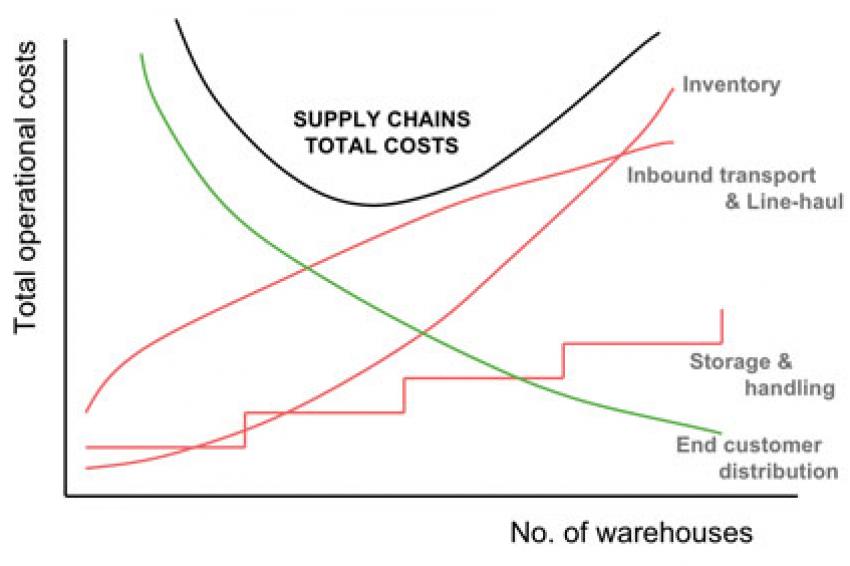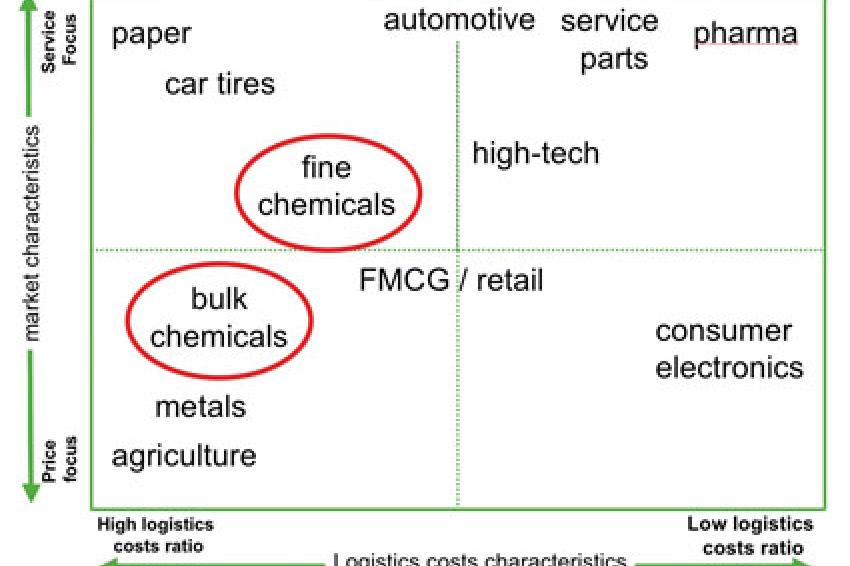Distribution Networks as a Recession Response
Is There A Competitive Distribution Network Strategy For The Chemical Industry?
Surviving the Downturn - The chemical industry has experienced one of the worst economic downturns in history - and it is a fact that the logistics costs in the chemical industry are higher than in most other industries. So it is no surprise that many chemical companies have turned to reconfiguring their distribution network to survive this challenging economic era. There are three primary aspects at hand: First, main-cost drivers when defining distribution strategy must be assessed. Second, product-, and market aspects determining the distribution requirements within chemicals need to be identified. Third, what distribution strategy is the best in order to comply with these distribution requirements?
The Main Cost Drivers for Distribution Strategy
A benchmark of the European Logistics Association (ELA) in 2008 shows that logistics costs have risen almost 20% since 2003 from about 6% in 2003 to 7.3% of net sales in 2008. There is an overall trend for distribution networks to adapt to more regionalized, consolidated structures to control these rising logistics costs and to cope with today's economic challenges. Such a financial distribution strategy is based on a balancing of all logistics costs factors (transport costs, warehouse costs and inventory costs) to obtain the lowest overall total supply chains costs (fig. 1).
There are large differences in the logistics costs per sector. Particularly the European chemical industry (about 8.5%) has a higher average logistics costs as a percentage of net sales than other sectors as automotive (5.5%), retail (5.5%) and pharmaceuticals (3%). This does not necessarily relate to a poor logistics performance within the chemical industry. It is rather an inevitable consequence of its typical productions characteristics (voluminous, bulky commodities with a high transportation effort) along a relative low sales value as compared to other industries.
These costs differences make it impossible to find standard cross-industry solutions when designing a distribution network. In this perspective, it is also worthwhile to make a further differentiation within the chemical industry, between bulk chemicals and fine/specialty chemicals. Although there are no formal benchmarks available, as a general rule fine chemicals companies have a better (read lower percentage) logistics costs ratio then bulk chemicals.
The Product- and Market Aspects that Drive Distribution Strategies
We have already seen that the logistics costs ratio is one of the determining factors in how to design distribution networks. Rather than talking about logistics costs, how a distribution strategy should be a derivate of a market strategy should also be addressed. How can supply chains help achieve a competitive advantage?
For that reason the other determining factor next to logistics costs, is what customers perceive as added-value in the market of operation. To be more precise, market advantage can be achieved by competing more on sales price or by competing more on customer service (delivery lead-time and -reliability).
These two decisive distribution network aspects of ratio of logistics costs against total net sales and customer service are translated into a four-quadrant model. Interesting in this model is to see where bulk- and fine chemicals are positioned compared to other industries (fig. 2).
The Optimal Distribution Strategy for Chemicals
There are a number of key factors that companies consider to measure their logistics success: establishment of an optimized chain network structures; a higher degree of flexibility; shorter customer lead-times; and systematic control of net working capital.
The question is how to relate the above aspects with a company's position in the four- quadrant distribution model. For this we have developed four typologies of distribution strategies that fit within each of the quadrants.
- Operational efficient distribution network (high logistics costs with price focus)
Given the relatively high logistics costs, the focus is on operational efficiency thus operating one single distribution center (DC) to achieve economies-of-scale. Covering the European marketplace with one DC is feasible, given lead-time is not a strategy driver as the market competes on price. The warehouse usually is located at the (largest) manufacturing plant to reduce inbound costs. It is important to have a strong focus on transportation efficiency through full-truck loads, as the shipped volumes are extremely large. This is done for instance by weekly milk runs per region or a maximization of direct deliveries from production plant to end customer. - Reliable distribution network (high logistics costs with service focus)
Short lead-times are an important factor, and therefore there are multiple warehouses to service important local markets. Inventory management (reduction of working capital) over these warehouses has limited management attention, as the value density of the products is low. Ergo the full product portfolio resides in all warehouses. Transport efficiency is achieved by bundling the replenishment flows from manufacturing plant to the warehouses in line hauls. Wherever possible the warehouses usually are located at a manufacturing plant to reduce inbound costs. Outbound transportation is relatively a small piece in the total costs pie, with the main markets having their own warehouse. - Asset efficient distribution network (low logistics costs with price focus)
Typically products with a high sales value, thus the focus is on inventory optimization (reduction of working capital), rather than operational savings in warehousing and transport. Typical solution is a dual structure with a central DC, supported by smaller local satellite warehouses. The central DC stocks both fast- and slow-movers with several weeks of demand coverage. The local satellite warehouses only stock the fast-movers for the local market, with a minimum of demand coverage. - Responsive, flexible distribution network (high logistics costs with price focus)
Given the relatively small logistics costs percentage in these branches, the focus is more on quality, reliability and responsiveness than it is on operational efficiency. These distribution structures typically have an over-dimensioning on the number of warehouses, i.e. each sales country has its own inventory and warehouse location. In service logistics, risk mitigation is often a supply chain topic. The penalty clauses or health risk (e.g. pharma) attached to a non-compliant delivery often outweigh any operational costs reduction in distribution. A responsive, flexible, reliable market strategy can also be created in a one DC structure where 24-hour service is assured through air-transport or consignment stocks at customers premises.
Use the Right Mixture of Distribution Networks
Given the high logistics costs in relation to net sales within the chemical industry, the distribution model should focus on operational efficiency. This means a consolidation of warehouses as much as the market requirements allow you, at the same time as optimizing transportation through condensed shipments.
Particularly fine chemicals could be faced with specific customer lead-time constraints drifting the distribution model away from its most efficient set-up. However this supplementary service solution (e.g. an extra warehouse) should only be implemented if the benefit in completive advantage outweighs the additional costs. Such a service solution should not become a business standard, but only apply for the product-market combination in question.
Consequently the key to logistics success within the chemical industry is to implement several different distribution networks within your company. Thus operating the most efficient distribution network, but allow for a tailored service solutions specifically for that product-market where it provides a proven added value. Manage distribution globally, but act locally.








